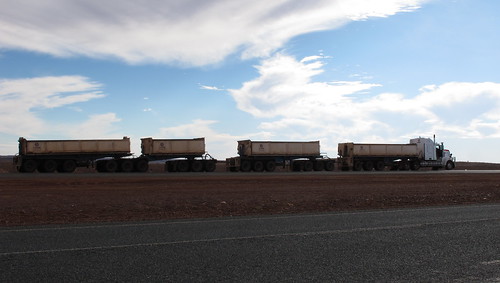 You can see them coming for miles: even on paved roads, a cloud of red dust churned up by their wake lets you know that a road train is coming.
You can see them coming for miles: even on paved roads, a cloud of red dust churned up by their wake lets you know that a road train is coming.
Large trucks with three or more trailers are common sights on many Australian roads. Carrying animals, ore, fuel and a wide range of products to (or from) remote areas, meeting them on the road for the first time is a knuckle-tightening experience.
This road train was at a rest area along an unpaved section of the Savannah Way in western Queensland. With three trailers and 72 tires to kick up dust and rocks, we were very glad to find it stopped!
 Signs along various highways advise drivers to allow at least a kilometre to pass a road train—and in our underpowered camper vans, even that was barely enough. Fortunately, the drivers are understanding, and often signalled to let us know that the road ahead was clear. Passing can still be dangerous though: in one instance, a kangaroo carcass on the road ahead made me pull in much closer than I would have liked. As well, the roads often become narrower on bridges, so you don’t want to pass these monsters while crossing a bridge.
Signs along various highways advise drivers to allow at least a kilometre to pass a road train—and in our underpowered camper vans, even that was barely enough. Fortunately, the drivers are understanding, and often signalled to let us know that the road ahead was clear. Passing can still be dangerous though: in one instance, a kangaroo carcass on the road ahead made me pull in much closer than I would have liked. As well, the roads often become narrower on bridges, so you don’t want to pass these monsters while crossing a bridge.
Australian roads sensibly have truck pull-offs, and frequent road signage encourage tired drivers to stop for a nap. We were always glad to see them in use because any collision with a road train would be serious.
The point was driven home very graphically on one lonely stretch of highway in the Kimberly region: the pavement had literally been melted where the many tires of a road train had locked up in an emergency stop. Despite the braking, the road train had hit the full-sized bullock whose broken carcass was being picked over by scavenger birds nearby. What was particularly sobering was that there was no evidence of broken headlights: the “bull bars” in front had done their job, and the road train had apparently been able to continue on its way.


